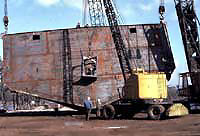Shipyard Employment eTool
Shipbreaking >> Materials Handling (including Gear and Equipment for Rigging)

Cranes, hoisting apparatus such as chain falls, winches, and marine railways, and their accompanying rigging gear, are used to move and lift materials and equipment during shipbreaking operations. Moving heavy loads in congested areas increases risk of injury.
Rigging methods and equipment are used to attach heavy loads to lifting devices (cranes, derricks, or chain falls). Rigging equipment may include: rope, chains, or synthetic webbing slings, which connect the loads to lifting machinery by means of hooks or shackles. Inadequate rigging methods or components may result in the load detaching and injuring workers.Serious injuries may result from:

- Equipment failure
- Improper use of equipment
- Getting caught between
- Getting struck by loads or rigging gear
The following topics are included in this section:

- Inspection
- Ropes, Chains, and Slings
- Shackles and Hooks
- Chain Falls and Pull-Lifts
- Hoisting and Hauling Equipment
- Use of Gear
Note: Confined space entry is one of the leading hazards associated with barge cleaning. Review Shipbreaking: Confined or Enclosed Spaces and Other Dangerous Atmospheres for information on how to protect workers from this hazard.

